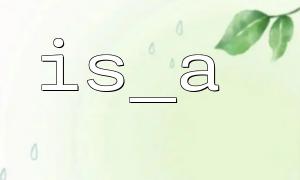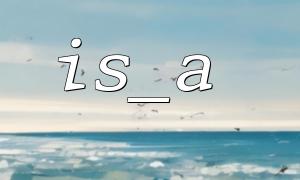is_a() is used to determine if an object is an instance of a specified class or a subclass of that class. The function signature is as follows:
bool is_a(object $object, string $class_name, bool $allow_string = false)
$object: The object to be checked.
$class_name: The name of the class as a string.
$allow_string (PHP 7.2+): Allows passing the class name as a string instead of an object (rarely used).
Example:
class Animal {}
class Dog extends Animal {}
<p>$dog = new Dog();</p>
<p>if (is_a($dog, 'Animal')) {<br>
echo "This is an object of class Animal or its subclass";<br>
}<br>
Here, is_a() returns true because Dog is a subclass of Animal.
property_exists() is used to check if an object has a specific property, regardless of whether the property is public, protected, or private. The function signature is:
bool property_exists(object|string $class, string $property)
$class: The object or class name as a string.
$property: The property name as a string.
Example:
class Person {
private $name;
public $age;
}
<p>$p = new Person();</p>
<p>if (property_exists($p, 'name')) {<br>
echo "Object has property name";<br>
}</p>
<p>if (property_exists($p, 'age')) {<br>
echo "Object has property age";<br>
}<br>
First, use is_a() to check whether the object belongs to a controllable class range.
Then use property_exists() to check whether the property exists.
Finally, use reflection or set access interfaces during design to ensure property access safety.
<?php
class User {
public $username;
protected $email;
private $password;
$this->username = $username;
$this->email = $email;
$this->password = $password;
}
}
function checkPropertyAccess($obj, $property, $allowedClass) {
// Check if the object is an instance of an allowed class or its subclass
if (!is_a($obj, $allowedClass)) {
return false;
}
// Check if the property exists
if (!property_exists($obj, $property)) {
return false;
}
// Use reflection to check the visibility of the property
$reflection = new ReflectionObject($obj);
if (!$reflection->hasProperty($property)) {
return false;
}
$prop = $reflection->getProperty($property);
// Check if the property is public
if ($prop->isPublic()) {
return true;
}
// If not public, it is not directly accessible, so access is restricted for safety
return false;
}
$user = new User('alice', 'alice@example.com', 'secret');
var_dump(checkPropertyAccess($user, 'username', 'User')); // true
var_dump(checkPropertyAccess($user, 'email', 'User')); // false
var_dump(checkPropertyAccess($user, 'password', 'User')); // false
var_dump(checkPropertyAccess($user, 'nonexist', 'User')); // false
var_dump(checkPropertyAccess(new stdClass(), 'username', 'User')); // false
is_a() is used to check if an object belongs to a class or one of its subclasses, ensuring safe access scope.
property_exists() is used to detect if an object has a specified property.
By combining reflection, you can further check the access permissions of a property, preventing illegal access to private or protected properties.
In actual development, to ensure property access safety, it is recommended to expose properties through encapsulation (e.g., getter/setter methods) rather than direct access.
By properly using these functions, you can significantly enhance the robustness and security of your code, reducing runtime errors and potential security risks.














